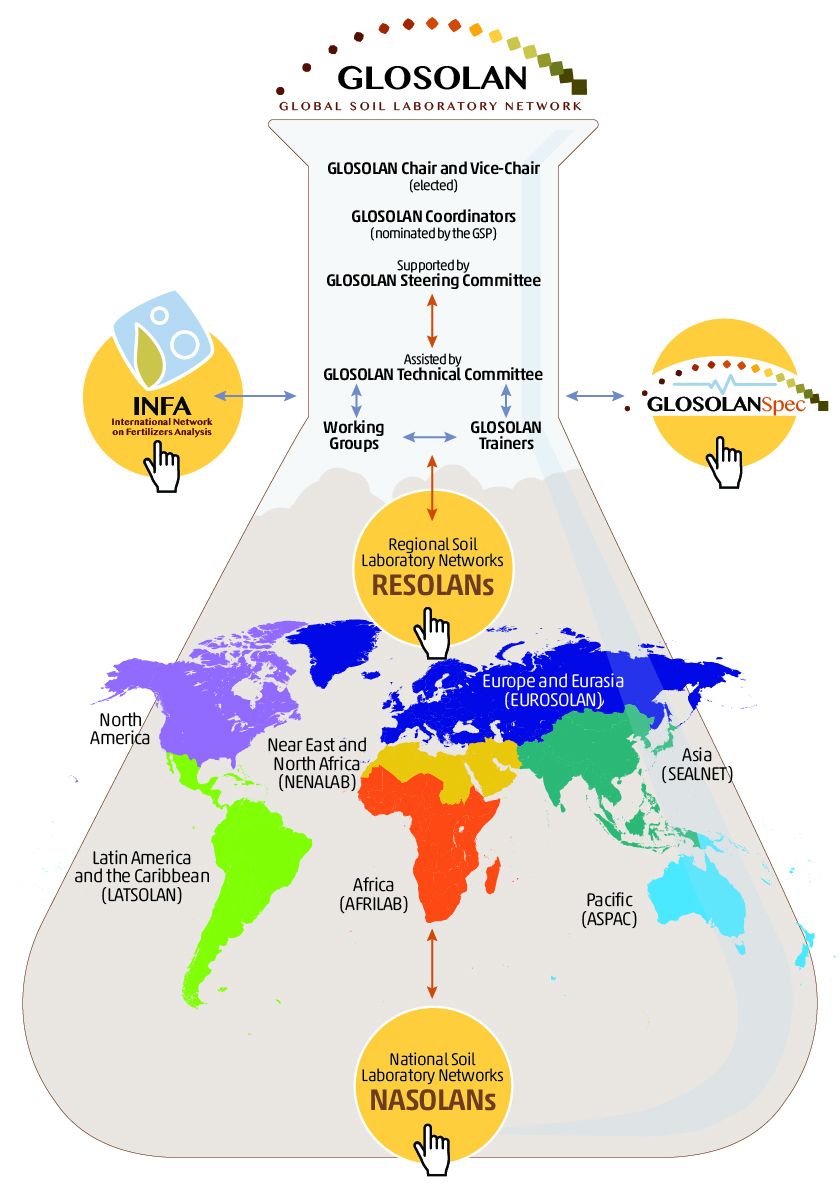Converting soil into data is what actually happens at a soil lab. But not every lab uses the same measurement methods and standards in its measurements. The United Nations' Food and Agriculture Organisation is aiming to harmonise soil monitoring worldwide. To that end, it has established a new global network – the Global Soil Laboratory Network. This is because adequate monitoring is necessary to be able to improve sustainable soil management. VITO is also part of this global network with its lab. And for Belgium and Luxembourg, it has already carried out a similar harmonisation exercise.
Not only is the world struggling with a climate crisis – things are not so rosy under our feet either. After all, soil is under pressure around the globe. No less than a third of the Earth's fertile soil has been designated ‘degraded’ (eroded). And this is problematic, certainly now that soils are also being used for climate and biodiversity functions alongside agriculture and building.
This was why, under the auspices of the UN's Food and Agriculture Organisation (FAO), the Global Soil Partnership was founded over ten years ago. Among other things, this aims to encourage land users and policy-makers towards more sustainable soil management.
Harmonising measurement methods
In order to promote sustainable soil management, however, the state of the soil needs to be known first. And this was why Glosolan was launched in 2017, this being the Global Soil Laboratory Network. ‘It's the same for the soil too: if you can't measure it, you can't manage it,’ says Kristof Tirez from VITO. ‘But different measurements, for example of soils at different places in the world, need to be able to be compared reliably too. However, that's often not possible.’ Tirez refers to a global map of organic carbon that the Global Soil Partnership composed several years ago. ‘That showed some great differences between countries that were solely the result of differing measurement methods used. Clearly, nothing like that is workable.’
But harmonising soil measurement methods globally is easier said than done. For organic carbon, for example – a crucial component of soil – there are two popular methods: a simple one based on chemical oxidisation of a soil sample, and a more complex one based on catalytic combustion of a sample. Whereas the first one is largely maintained in poorer countries (for example, there is no expensive equipment and not even any electrical power needed for it), the second one is mainly popular in industrialised regions. Moreover, the first method is also discouraged in Europe because it uses dichromate, a toxic and carcinogenic substance.
Glosolan is attempting to harmonise the soil measurement methods and data worldwide, for measurements of organic carbon as well as many other soil parameters. The harmonisation is taking place bottom-up, through Glosolan's sub-networks. Tirez: ‘The worldwide network is divided into seven continental networks. The most important network for us is Eurosolan, which was founded in 2019 and has 250 soil labs from Europe and Eurasia. Each of these labs is represented in this network, in which information is then exchanged, for example on best practices regarding soil monitoring.’
Putting our own house in order
There were initially two Belgian soil labs in Eurosolan – VITO's and Gembloux Agro-Bio Tech (GxABT)'s of the University of Liège, respectively the reference labs for Flanders and Wallonia. ‘As part of an overall harmonisation exercise, however, we found this a strange situation,’ continues Tirez. ‘We found that we first had to put our own house in order, by organising a harmonisation at the Belgian level. This was how Besolan came about in 2021, a Belgian network for soil monitoring that has twenty soil labs, including those of VITO and GxABT as well as those of universities, of the Bodemkunstige Dienst van België (‘Belgian Soil Service’) and several commercial labs. The initiative took hold, and the Grand Duchy of Luxembourg joined the network in 2023 too. Through Besolan, soil experts get to know each other better, sharing best practices and informing one another of new developments in soil monitoring. Its operation is supported by the Flemish Government.
During a webinar organised by Besolan in the summer of 2023, the focus was on the monitoring of organic carbon in the soil. ‘Organic carbon is of vital importance for healthy soil,’ explains Tirez. ‘It makes the soil spongy so it can retain water, it ensures soil life, but it also plays a major role in CO2 storage.’ By raising the proportion of organic carbon, soils can be made more healthy, fertile and resilient – in short, more sustainable. But to do so, then, the presence and concentration of organic carbon in the soil needs to be known first. This was precisely why the FAO put together the global organic carbon map at the time.
The FAO is counting on the efforts of the Glosolan network's members. ‘Its success stands and falls with the members' participation, supporting one another within their country or region, or even at a global scale, to reach a decent level of soil data quality,’ says Filippo Benedetti from the FAO. ‘For example, experts from Eurosolan have taken several opportunities to organise competence tests in other parts of the world. In addition, European labs have acted as trainers in a range of webinars on the implementation of standard procedures, on soil analyses, quality control and a safe and healthy working environment in the lab.’
Policy on soil and soil monitoring in moving in European terms too. In 2023, the European Commission presented the Soil Directive as part of the Green Deal. This aims to bring all soil in the EU back to a healthy state by 2050. Organic carbon is a major parameter there, along with others such as water retention, acidity, chemical decontamination as well as soil compaction, for example. Following the European Directive, the Flemish Soil Decree will be amended in early 2024 too.
In the meantime, VITO has been following the European developments in the harmonisation of measurement and analysis methods for soil and soil improvement resources closely as well. As a reference lab, it is coordinating and facilitating the conversion of European standards into Flemish reference methods, thus ensuring harmonised soil data at all levels of policy.
Finally, alongside lab methods for soil monitoring, VITO is also conducting research into alternatives. These include, for example, the use of remote sensing, just as is already taking place in the monitoring of agricultural crops. VITO has a great deal of experience in this, of course. ‘Satellite imagery offers a wider perspective of the state of the soil,’ says Anne Gobin of VITO. ‘Measurements at various wavelengths of the light spectrum provide indirect information on properties of soils, from the scale of a field or acre to a regional scale. The data can be used to identify spatial variations, meaning farmers and policy-makers can make well-considered decisions regarding sustainable land use and soil health.’




